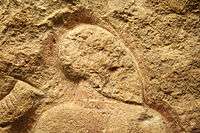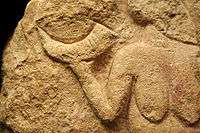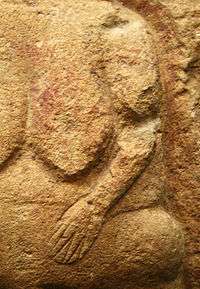Venus of Laussel
The Venus of Laussel is an 18.11-inch-high (46.0-centimetre) limestone bas-relief of a nude woman. It is painted with red ochre and was carved into the limestone of a rock shelter (Abri de Laussel) in the commune of Marquay, in the Dordogne department of south-western France. The carving is associated with the Gravettian Upper Paleolithic culture (approximately 25,000 years old). It is currently displayed in the Musée d'Aquitaine in Bordeaux, France.




Description
According to Riane Eisler, in her right hand the figure holds a crescent moon notched with thirteen markings: the number of lunar cycles in a year. Her other hand, as if to instruct us of the relationship between the cycles of the moon and women’s menstrual cycles, points to her vagina.[Eisler, Sacred Pleasure: Sex, Myth, and the Politics of the Body,p.61.]
She has large breasts and vulva. There is a "Y" on her thigh and her faceless head is turned toward the crescent moon.
Discovery and display
The figure was discovered in 1911 by Jean-Gaston Lalanne, a physician. It was carved into large block of limestone in a rock shelter (abri de Laussel) at the commune of Marquay in the Dordogne department of south-western France. The limestone block fell off the wall of the shelter. It was brought to the Musée d'Aquitaine in Bordeaux, France.
References
Works cited
Eisler, Riane (1995), Sacred Pleasure: Sex, Myth, and the Politics of the Body, HarperCollins Publishers Inc., NY.
Marshack, Alexander (1971), The Roots of Civilization, Moyer Bell Ltd, Mount Kisco, NY.
External links
| Wikimedia Commons has media related to Venus of Laussel. |